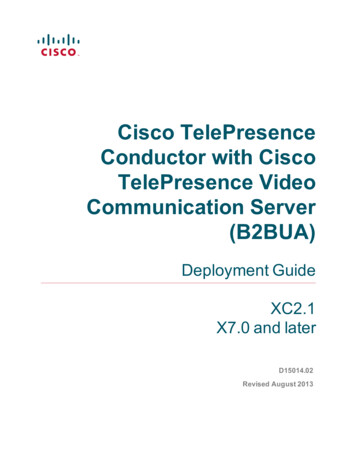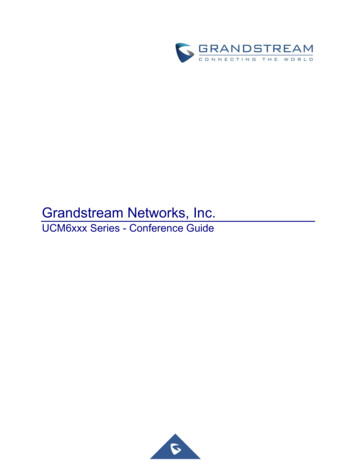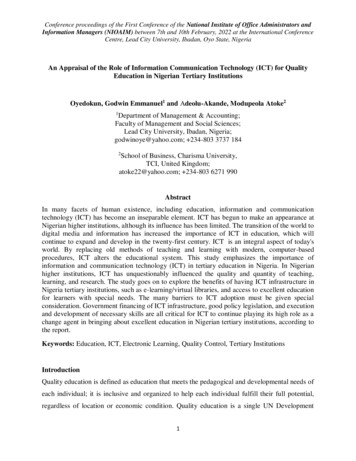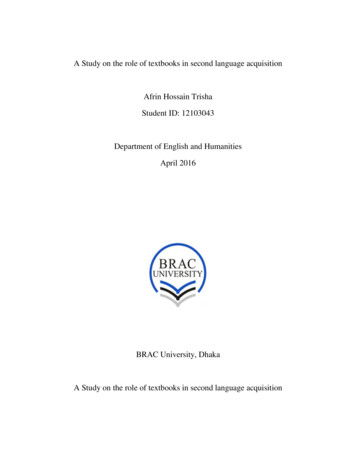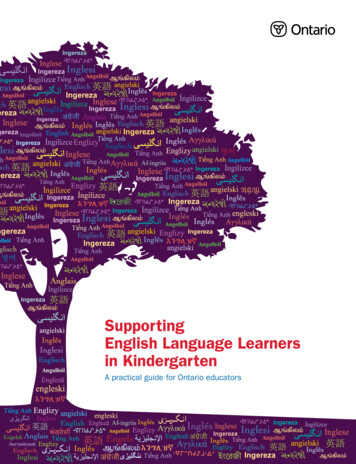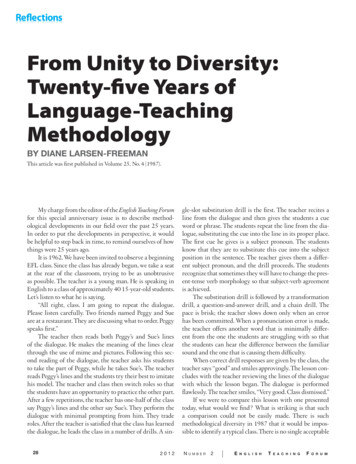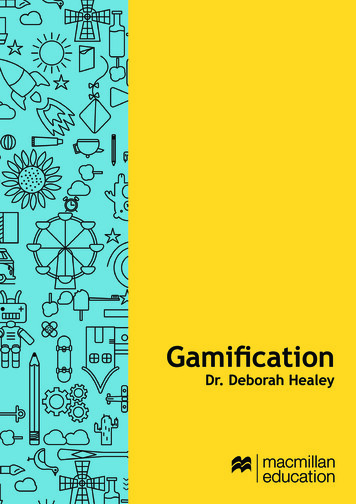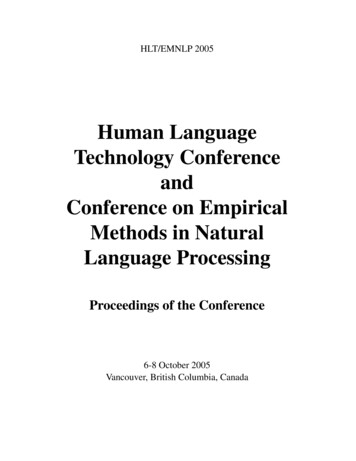
Transcription
HLT/EMNLP 2005Human LanguageTechnology ConferenceandConference on EmpiricalMethods in NaturalLanguage ProcessingProceedings of the Conference6-8 October 2005Vancouver, British Columbia, Canada
Production and Manufactured byOmnipress Inc.Post Office Box 7214Madison, WI 53707-7214The conference organizers are grateful to the following sponsors for theirgenerous support.Silver Sponsor:Bronze Sponsors:Sponsor of Best Student Paper Award:This year's HLT/EMNLP conference is co-sponsored by ACL SIGDAT.Copyright 2005 The Association for Computational LinguisticsOrder copies of this and other ACL proceedings from:Association for Computational Linguistics (ACL)3 Landmark CenterEast Stroudsburg, PA 18301USATel: 1-570-476-8006Fax: 1-570-476-0860acl@aclweb.orgii
Preface: General ChairIn 2005, the Human Language Technology Conference (HLT) and the Conference on EmpiricalMethods in Natural Language Processing (EMNLP) were held together as a joint conference for thefirst time. The conference was co-sponsored by the organization traditionally behind HLT, the HumanLanguage Technology Advisory Board, and the organization traditionally behind EMNLP, SIGDAT:The Association for Computational Linguistics (ACL) Special Interest Group on linguistic data andcorpus-based approaches to natural-language processing. The joint conference was held in Vancouver,B.C., Canada on October 6–8, co-located with the 2005 Document Understanding Conference (DUC)and the 9th International Workshop on Parsing Technologies (IWPT).In the HLT tradition, the conference especially encouraged submissions involving synergisticcombinations of language technologies from the sometimes disjoint areas of natural-languageprocessing, speech processing, and information retrieval. To encourage such cross-fertilization, each ofthe major chair positions were filled by three people, one from each of these research areas.First, I would like to thank the Program Chairs, Chris Brew, Lee-Feng Chien, and Katrin Kirchhoff,for handling the unexpectedly large number of submissions under a very tight schedule and puttingtogether an excellent program for the conference. Please see their preface for further information onthe submissions, the program committee, and the conference program.Priscilla Rasmussen deserves our enduring gratitude for agreeing to serve as a remote LocalArrangements Chair, and gracefully handling the multitude of responsibilities that this importantposition requires.Joyce Chai did an excellent job as Publications Chair and managing the myriad of details required toassemble this proceedings in the small amount of time allotted for this important step. Thanks also goto Chen Zhang and Shaolin Qu for helping with the proceedings and to Jason Eisner and PhilippKoehn for making the publication software available and providing many good suggestions.Donna Byron, Anand Venkataraman, and Dell Zhang served as Demonstrations Chairs and carefullyreviewed 31 proposals to select 20 interesting demos that were a great addition to the conferenceprogram.David Elworthy and Marius Pasca served in the important role of Sponsorship and Exhibits Chairsand helped raise important corporate financial support for the conference. Thanks are also due to ourcorporate sponsors (listed on the previous page) for their gracious support.Srinivas Bangalore, Zak Shafran, and Hsin-Min Wang served as Publicity Chairs and providedimportant support in advertising the conference to the NLP, speech, and IR communities.Anoop Sarkar and Fred Popowich served as Local Preparation and Student Volunteer Coordinators,providing important local support in Vancouver and assembling and managing a team of studentvolunteers that provided important services at the conference. The students volunteers themselves alsodeserve our gratitude.Yuk Wah Wong, Razvan Bunescu, Ruifang Ge, and Rohit Kate dedicated significant effort asiii
Webmasters, putting together and constantly updating the conference web site.Graeme Hirst provided important support and advice as Chair of the HLT Board, particularly in thesite selection and initial formation of the conference committee. The members of the HLT Board,Karen Kukich, Donna Harman, Mary Harper, Julia Hirschberg, Sanjeev Khudanpur, JosephOlive, John Prange, Drago Radev, and Ellen Riloff, also provided important support and advice.Ken Church also provided important support and advice as chair of SIGDAT in the initial formationof the conference committee and continuing advice on conference organization.Also thanks to Donna Harman for organizing the co-located DUC meeting and Harry Bunt, RobMalouf and Alon Lavie for organizing the co-located IWPT meeting.Finally, I would to thank all of the authors, demo presenters, and conference attendees for helping tomake the first joint HLT/EMNLP meeting a successful and engaging scientific venue!Raymond J. MooneyHLT/EMNLP-05 General ChairAugust 24, 2005iv
Preface: Program Co-chairsIt is our pleasure to welcome you to HLT/EMNLP 2005 in the beautiful city of Vancouver. For thethird time, HLT is being held in combination with a conference sponsored by an ACL organization,thus continuing the tradition of bringing together researchers from three different communities: naturallanguage processing, information retrieval, and speech processing. During the last few years, thesefields have experienced a growing trend towards interaction across their traditional boundaries, asevidenced by the exchange of approaches and methodologies, and the development of large-scalesystems integrating speech and language processing as well as information retrieval components.We hope that this conference will further encourage this trend. In order to facilitate the interactionbetween researchers from different fields, all papers have been organized into a single track ratherthan two or three different tracks. We are also pleased to welcome three invited speakers whose workspans several areas in the HLT/EMNLP field: Ellen Vorhees, Larry Hunter, and Sanjeev Khudanpur.We would like to thank them again for accepting our invitation and for their exciting and stimulatingcontributions to our program.The joint organization of HLT and EMNLP generated an unusually large load of papers. A totalof 402 submissions were received, of which 127 were accepted, resulting in an acceptance rate of31.6%. We would like to thank our technical chairs, who did an excellent job at selecting the programcommittee and managed to handle the large number of submissions efficiently and on time. Our thanksalso go to the program committee members for their expert reviews. We are particularly gratefulto those PC members who were willing to take on additional reviews beyond their original assignments.For the demonstrations track, thirty-one submissions were received, twenty of which were accepted.Donna Byron, Anand Venkataramanan and Dell Zhang did a superb job at managing the demosubmissions and reviews, and we are looking forward to a very interesting session.We are please to announce that, for the first time, a prize for the best student paper will be awarded atthis year’s conference. We are especially grateful to IBM for sponsoring this award – educating futuregenerations of researchers in our community is of prime importance, and the public acknowledgmentof students’ research achievements is a significant contribution towards this goal.Finally, we would like to thank our general chair, Ray Mooney, for his help and guidance, and allorganizers, PC members, technical chairs, authors, and attendees for their efforts and contributions. Wewish you a pleasant time at HLT/EMNLP 2005!Chris Brew, Lee-Feng Chien, and Katrin KirchhoffProgram Co-chairsAugust 24, 2005v
Conference OrganizersGeneral ChairRaymond J. Mooney, The University of Texas at AustinProgram ChairsChris Brew, The Ohio State UniversityLee-Feng Chien, Academia SinicaKatrin Kirchhoff, University of WashingtonDemonstrations ChairsDonna Byron, The Ohio State UniversityAnand Venkataraman, SRI InternationalDell Zhang, Birkbeck, University of LondonPublications ChairJoyce Chai, Michigan State UniversityPublicity ChairsSrinivas Bangalore, AT&T Labs - ResearchZak Shafran, Johns Hopkins UniversityHsin-Min Wang, Academia SinicaSponsorship and Exhibits ChairsMarius Pasca, GoogleDavid Elworthy, GoogleLocal Arrangements ChairPriscilla Rasmussen, Assoc. for Computational LinguisticsLocal Preparation and Student Volunteer CoordinatorsFred Popowich, Simon Fraser UniversityAnoop Sarkar, Simon Fraser UniversityWebmastersYuk Wah Wong, The University of Texas at AustinRazvan Bunescu, The University of Texas at AustinRuifang Ge, The University of Texas at AustinRohit Kate, The University of Texas at Austinvii
viii
Program CommitteeChairsChris Brew, The Ohio State UniversityLee-Feng Chien, Academia SinicaKatrin Kirchhoff, University of WashingtonArea ChairsRicardo Baeza-Yates, University of ChileRegina Barzilay, Massachusetts Institute of TechnologyJennifer Chu-Carroll, IBM T. J. Watson Research CenterPascale Fung, Hong Kong University of Science and TechnologyTimothy Hazen, Massachusetts Institute of TechnologyRebecca Hwa, University of PittsburghFrank Keller, University of EdinburghElizabeth D. Liddy, University of SyracuseDan Melamed, New York UniversityHelen Meng, Chinese University of Hong KongMark-Jan Nederhof, University of GroningenHwee Tou Ng, National University of SingaporeDan Roth, University of Illinois at Urbana/ChampaignMurat Saraclar, AT&T Labs - ResearchSimone Teufel, University of CambridgeWayne Ward, University of ColoradoJanyce Wiebe, University of PittsburghCheng Xiang Zhai, University of Illinois at Urbana/ChampaignMing Zhou, Microsoft Research AsiaProgram Committee MembersAlex Acero (Microsoft Research), Gilles Adda (LIMSI/CNRS, France), Lars Ahrenberg (Linkoping University), Shlomo Argamon (Illinois Institute of Technology)Michiel Bacchiani (IBM), Ricardo Baeza-Yates (ICREA-UPF & CWR/DCC-Univ. de Chile),Srinivas Bangalore (AT&T Labs - Research), Regina Barzilay (Massachusetts Institute of Technology), Frederic Bechet (LIA, University of Avignon, France), Jerome Bellegarda (Apple Computer), Dan Bikel (IBM Research), Patrick Blackburn (INRIA Lorraine, France), Johan Bos (University of Edinburgh), Antal van den Bosch (Tilburg University, Netherlands), Herve Bourlard(IDIAP Research Institute), Chris Brew (The Ohio State University), Ralf Brown (Carnegie Mellon University), Bill Byrne (The Johns Hopkins University), Donna Byron (The Ohio State University)Jamie Callan (Carnegie Mellon University), Claire Cardie (Cornell University), Rolf Carlson(Royal Institute of Technology, Sweden), Xavier Carreras Perez (Universitat Politècnica de Catalunya),John Carroll (University of Sussex), Joyce Chai (Michigan State University), Soumen Chakrabartiix
(IIT Bombay, India), Ciprian Chelba (Microsoft Research), Francine Chen (Palo Alto ResearchCenter), John Chen (Columbia University), Stanley Chen (IBM T.J. Watson Research Center),David Chiang (University of Maryland), Lee-Feng Chien (Academia Sinica), Jennifer Chu-Carroll(IBM T. J. Watson Research Center), Grace Chung (Corporation For National Research Initiatives), Ken Church (Microsoft), Stephen Clark (Oxford University), Charlie Clarke (University ofWaterloo), Michael Collins (Massachusetts Institute of Technology), Ann Copestake (Universityof Cambridge), Max Copperman, Mark Core (ISI, University of Southern California), StephenCox (University of East Anglia), Krzysztof Czuba (IBM T.J. Watson Research Center)Walter Daelemans (University of Antwerp, Belgium), Ido Dagan (Bar Ilan University, Israel), Renato DeMori (University of Avignon), Mona Diab (Columbia University), Anne Diekema (Syracuse University), Barbara DiEugenio (University of Illinois, Chicago), Shona Douglas (AT&TLabs - Research), John Dowding (National Aeronautics and Space Administration), Amit Dubey(University of Edinburgh), Susan Dumais (Microsoft Research)Michael Elhadad (Ben-Gurion University of the Negev), Noemie Elhadad (Columbia University), Hakan Erdogan (Sabanci University), Katrin Erk (Saarland University)David Ferrucci (IBM T.J. Watson Research Center), Radu Florian (IBM Research), Eric FoslerLussier (The Ohio State University), George Foster (National Research Council, Canada), Pascale Fung (HLTC/HKUST), Sadaoki Furui (Tokyo Insitute of Technology)Jianfeng Gao (Microsoft Research Asia), Fred Gey (University of California, Berkeley), DanGildea (University of Rochester), Roxana Girju (University of Illinois at Urbana/Champaign),Jade Goldstein (U.S. Department of Defense), Julio Gonzalo (UNED, Spain), Mark Greenwood(University of Sheffield), Greg Grefenstette (CEA, France), Ling Guan (Ryerson University,Toronto), Curry Guinn (University of North Carolina at Wilmington)Nizar Habash (Columbia University), Udo Hahn (Freiburg University), Thomas Hain (University of Sheffield), Dilek Hakkani-Tur (AT&T Labs - Research), John Hale (Michigan State University), Hans van Halteren (Radboud University Nijmegen), Sanda Harabagiu (University ofTexas, Dallas), Mary Harper (Purdue University), Mark Hasegawa-Johnson (University of Illinois, Urbana/Champaign), T. J. Hazen (Massachusetts Institute of Technology), James Henderson (Université de Genève), Julia Hirschberg (Columbia University), Graeme Hirst (Universityof Toronto, Canada), Julia Hockenmaier (University of Pennsylvania), Thomas Hofmann (BrownUniversity), Ed Hovy (ISI, University of Southern California), David Hull (Clairvoyance Corp.),Rebecca Hwa (University of Pittsburgh)Rukmini Iyer (Nuance Communications)Donghong Ji (Institute for Infocomm Research, Singapore), Rong Jin (Michigan State University), Michael Johnston (AT&T Labs - Research), Pamela Jordan (University of Pittsburgh)Min-Yen Kan (National University of Singapore), Tatsuya Kawahara (Kyoto University), AndyKehler (University of California, San Diego), Frank Keller (University of Edinburgh), StephanKepser (Eberhard Karls Universität Tübingen, Germany), Katrin Kirchhoff (University of Washington), Dan Klein (University of California, Berkeley), Kevin Knight (ISI, University of Southern California), Philipp Koehn (University of Edinburgh), Geert-Jan Kruijff (Universität des Saar-x
landes, Saarbrücken, Germany), Jonas Kuhn (The University of Texas at Austin), Roland Kuhn(NRC Institute for Information Technology), Shankar Kumar (Johns Hopkins University), SadaoKurohashi (University of Tokyo, Japan)Mirella Lapata (University of Edinburgh, UK), Alon Lavie (Carnegie Mellon University), LinShan Lee (National Taiwan University), Oliver Lemon (Edinburgh University), Anton Leuski(University of Southern California), Roger Levy (Stanford University), Mingjing Li (MicrosoftResearch Asia), Xin Li (University of Illinois at Urbana/Champaign), Elizabeth D. Liddy (Syracuse University), Chin-Yew Lin (ISI, University of Southern California), Dekang Lin (Google),Ting Liu (Harbin Institute of Technology, China), Yang Liu (International Computer Science Institute. Berkeley), Karen Livescu (Massachusetts Institute of Technology), Xiaofei Lu (The OhioState University), Yajuan Lu (Microsoft Research Asia)Lidia Mangu (IBM T.J. Watson Research Center), Inderjeet Mani (Georgetown University),Christopher (Manning Stanford University), Daniel Marcu (ISI, University of Southern California), Katja Markert (University of Leeds, UK), Yuval Marom (Monash University), Lluı́sMàrquez i Villodre (Universitat Politècnica de Catalunya, Spain), Yuji Matsumoto (Nara Institute of Science and Technology, Japan), Andrew McCallum (University of Massachusetts),Diana McCarthy (University of Sussex, UK), Kathleen (McKeown Columbia University), DanMelamed (New York University), Chris Mellish (University of Aberdeen), Helen Meng (Chinese University of Hong Kong), Rada Mihalcea (University of North Texas), Dan Moldovan(University of Texas, Dallas), Christof Monz (University of Maryland), Bob Moore (MicrosoftResearch), Tatsunori Mori (Yokohama National University), Sung Hyon Myaeng (Informationand Communications University, Korea)Shri Narayanan (University of Southern California), Mark-Jan Nederhof (University of Groningen), Hermann Ney (RWTH Aachen University), Hwee Tou Ng (National University of Singapore), Vincent Ng (University of Texas at Dallas), Grace Ngai (Hong Kong Polytechnic University), Jian-Yun Nie (University of Montreal), Cheng Niu (Cymfony Corp.), Eric Nyberg (CarnegieMellon University)Doug Oard (University of Maryland), Franz Och (Google), Kemal Oflazer (Sabanci University,Turkey), Els den Os (Radboud University Nijmegen), Miles Osborne (University of Edinburgh),Douglas O’Shaughnessy (INRS-Telecommunications)Martha Palmer (University of Pennsylvania), Shimei Pan (IBM T. J. Watson Research Center),Patrick Pantel (ISI, University of Southern California), Kishore Papineni (IBM Research), Cecile Paris (CSIRO, Australia), Marius Pasca (Google), Bryan Pellom (University of Colorado),Gerald Penn (University of Toronto, Canada), Fernando Pereira (University of Pennsylvania),Michael Picheny (IBM T. J. Watson Research Center), Joe Picone (Mississippi State University),Roberto Pieraccini (IBM), Massimo Poesio (University of Essex), Fred Popowich (Simon FraserUniversity), John Prager (IBM Reserch), Harry Printz (Agile TV Corporation), Stephen Pulman(Oxford University), Vasin Punyakanok (University of Illinois at Urbana/Champaign)Dragomir Radev (University of Michigan, Ann Arbor), Bhuvana Ramabhadran (IBM), OwenRambow (Columbia University), Jason Rennie (Massachusetts Institute of Technology), PhilipResnik (University of Maryland), Christian Retoré (Université Bordeaux 1, France), GiuseppeRiccardi (AT&T Labs - Research), Steve Richardson (Microsoft Research), Frank Richter (Eber-xi
hard Karls Universität Tübingen, Germany), Stefan Riezler (Palo Alto Research Center), German Rigau (Universitat Politècnica de Catalunya, Spain), Ellen Riloff (University of Utah), HaeChang Rim (Korea University), Brian Roark (Oregon Health and Sciences University), SteveRobertson (Microsoft Research), Dan Roth (University of Illinois at Urbana/Champaign), SalimRoukos (IBM Research ), Alex Rudnicky (Carnegie Mellon University)Yoshinori Sagisaka (ATR/Waseda University), Mark Sanderson (University of Sheffield), MuratSaraclar (AT&T Labs - Research), Hinrich Schuetze (University of Stuttgart, Germany), SabineSchulte im Walde (Universität des Saarlandes, Saarbrücken, Germany), Fabrizio Sebastiani (Italian National Council of Research, Italy), Frank Seide (Microsoft Research Asia), Stephanie Seneff (Massachusetts Institute of Technology), Jimi Shanahan (Clairvoyance Corp), Libin Shen(University of Pennsylvania), Ronnie Smith (East Carolina University), Frank Soong (MicrosoftResearch Asia), Karen Sparck Jones (University of Cambridge), Richard Sproat (University ofIllinois, Urbana/Champaign), Dave Stallard (BBN Technologies), Mark Steedman (Universityof Edinburgh), Volker Steinbiss (Accipio Consulting), Amanda Stent (Stony Brook University),Suzanne Stevenson (University of Toronto), Michael Strube (EML Research), Tomek Strzalkowski (University at Albany), Keh-Yih Su (Behavior Design Corporation), Eiichiro (SumitaATR), Stan Szpakowicz (University of Ottawa)Joel Tetreault (University of Rochester), Simone Teufel (University of Cambridge), ChristophTillmann (IBM Research), Tassos Tombros (Queen Mary, University of London), Kristina Toutanova(Stanford University), Gokhan Tur (AT&T Labs - Research)Takehito Utsuro (Kyoto University)Andreas Vlachos (Cambridge University), Stephan Vogel (Carnegie Mellon University), EllenVoorhees (National Institute of Standards and Technology), Sarel van Vuuren (University of Colorado)Chao Wang (Massachusetts Institute of Technology), Wei Wang (University of North Carolinaat Chapel Hill), Ye-Yi Wang (Microsoft Research), Wayne Ward (University of Colorado), TaroWatanabe (NTT Communication Science Lab), Andy Way (Dublin City University), BonnieWebber (University of Edinburgh), Ralph Weischedel (BBN Technologies), Jan Wiebe (University of Pittsburgh), Hugh Williams (Microsoft Corporation), Florian Wolf (University of Cambridge), Dekai Wu (Hong Kong University of Science and Technology), Xiaoyun Wu (Yahoo)Fei Xia (IBM Research)Scott Wentau Yih (Microsoft Research), Steve Young (University of Cambridge)Hugo Zaragoza (Microsoft Research, Cambridge), Luke Zettlemoyer (Massachusetts Instituteof Technology), Cheng Xiang Zhai (University of Illinois at Urbana/Champaign), Ming Zhou(Microsoft Research Asia), Dav Zimak (University of Illinois at Urbana/Champaign)xii
Table of ContentsImproving LSA-based Summarization with Anaphora ResolutionJosef Steinberger, Mijail Kabadjov, Massimo Poesio and Olivia Sanchez-Graillet . . . . . . . . . . . . . 1Data-driven Approaches for Information Structure IdentificationOana Postolache, Ivana Kruijff-Korbayova and Geert-Jan Kruijff . . . . . . . . . . . . . . . . . . . . . . . . . . . . 9Using Semantic Relations to Refine Coreference DecisionsHeng Ji, David Westbrook and Ralph Grishman . . . . . . . . . . . . . . . . . . . . . . . . . . . . . . . . . . . . . . . . . . 17On Coreference Resolution Performance MetricsXiaoqiang Luo . . . . . . . . . . . . . . . . . . . . . . . . . . . . . . . . . . . . . . . . . . . . . . . . . . . . . . . . . . . . . . . . . . . . . . . . 25Improving Multilingual Summarization: Using Redundancy in the Input to Correct MT errorsAdvaith Siddharthan and Kathleen McKeown . . . . . . . . . . . . . . . . . . . . . . . . . . . . . . . . . . . . . . . . . . . . 33Error Detection Using Linguistic FeaturesYongmei Shi and Lina Zhou . . . . . . . . . . . . . . . . . . . . . . . . . . . . . . . . . . . . . . . . . . . . . . . . . . . . . . . . . . . . 41Semantic Similarity for Detecting Recognition Errors in Automatic Speech TranscriptsDiana Inkpen and Alain Désilets . . . . . . . . . . . . . . . . . . . . . . . . . . . . . . . . . . . . . . . . . . . . . . . . . . . . . . . . 49Redundancy-based Correction of Automatically Extracted FactsRoman Yangarber and Lauri Jokipii . . . . . . . . . . . . . . . . . . . . . . . . . . . . . . . . . . . . . . . . . . . . . . . . . . . . . 57NeurAlign: Combining Word Alignments Using Neural NetworksNecip Fazil Ayan, Bonnie J. Dorr and Christof Monz . . . . . . . . . . . . . . . . . . . . . . . . . . . . . . . . . . . . . . 65A Discriminative Matching Approach to Word AlignmentBen Taskar, Lacoste-Julien Simon and Klein Dan . . . . . . . . . . . . . . . . . . . . . . . . . . . . . . . . . . . . . . . . . 73A Discriminative Framework for Bilingual Word AlignmentRobert C. Moore . . . . . . . . . . . . . . . . . . . . . . . . . . . . . . . . . . . . . . . . . . . . . . . . . . . . . . . . . . . . . . . . . . . . . . 81A Maximum Entropy Word Aligner for Arabic-English Machine TranslationAbraham Ittycheriah and Salim Roukos . . . . . . . . . . . . . . . . . . . . . . . . . . . . . . . . . . . . . . . . . . . . . . . . . . 89A Large-Scale Exploration of Effective Global Features for a Joint Entity Detection and Tracking ModelHal Daumé III and Daniel Marcu . . . . . . . . . . . . . . . . . . . . . . . . . . . . . . . . . . . . . . . . . . . . . . . . . . . . . . . . 97Novelty Detection: The TREC ExperienceIan Soboroff and Donna Harman . . . . . . . . . . . . . . . . . . . . . . . . . . . . . . . . . . . . . . . . . . . . . . . . . . . . . . . 105Tell Me What You Do and I’ll Tell You What You Are: Learning Occupation-Related Activities forBiographiesElena Filatova and John Prager . . . . . . . . . . . . . . . . . . . . . . . . . . . . . . . . . . . . . . . . . . . . . . . . . . . . . . . . 113xiii
Using Names and Topics for New Event DetectionGiridhar Kumaran and James Allan . . . . . . . . . . . . . . . . . . . . . . . . . . . . . . . . . . . . . . . . . . . . . . . . . . . . 121Investigating Unsupervised Learning for Text Categorization BootstrappingAlfio Gliozzo, Carlo Strapparava and Ido Dagan . . . . . . . . . . . . . . . . . . . . . . . . . . . . . . . . . . . . . . . . . 129Speeding up Training with Tree Kernels for Node Relation LabelingJun’ichi Kazama and Kentaro Torisawa . . . . . . . . . . . . . . . . . . . . . . . . . . . . . . . . . . . . . . . . . . . . . . . . . 137Kernel-based Approach for Automatic Evaluation of Natural Language Generation Technologies: Application to Automatic SummarizationTsutomu Hirao, Manabu Okumura and Hideki Isozaki . . . . . . . . . . . . . . . . . . . . . . . . . . . . . . . . . . . 145Discretization Based Learning for Information RetrievalDmitri Roussinov and Weiguo Fan . . . . . . . . . . . . . . . . . . . . . . . . . . . . . . . . . . . . . . . . . . . . . . . . . . . . . 153Local Phrase Reordering Models for Statistical Machine TranslationShankar Kumar and William Byrne. . . . . . . . . . . . . . . . . . . . . . . . . . . . . . . . . . . . . . . . . . . . . . . . . . . . .161HMM Word and Phrase Alignment for Statistical Machine TranslationYonggang Deng and William Byrne . . . . . . . . . . . . . . . . . . . . . . . . . . . . . . . . . . . . . . . . . . . . . . . . . . . . 169Inner-Outer Bracket Models for Word Alignment using Hidden BlocksBing Zhao, Niyu Ge and Kishore Papineni . . . . . . . . . . . . . . . . . . . . . . . . . . . . . . . . . . . . . . . . . . . . . . 177Alignment Link Projection Using Transformation-Based LearningNecip Fazil Ayan, Bonnie J. Dorr and Christof Monz . . . . . . . . . . . . . . . . . . . . . . . . . . . . . . . . . . . . . 185Predicting Sentences using N-Gram Language ModelsSteffen Bickel, Peter Haider and Tobias Scheffer. . . . . . . . . . . . . . . . . . . . . . . . . . . . . . . . . . . . . . . . .193Training Neural Network Language Models on Very Large CorporaHolger Schwenk and Jean-Luc Gauvain . . . . . . . . . . . . . . . . . . . . . . . . . . . . . . . . . . . . . . . . . . . . . . . . . 201Minimum Sample Risk Methods for Language ModelingJianfeng Gao, Hao Yu, Wei Yuan and Peng Xu . . . . . . . . . . . . . . . . . . . . . . . . . . . . . . . . . . . . . . . . . . 209A Salience Driven Approach to Robust Input Interpretation in Multimodal Conversational SystemsJoyce Y. Chai and Shaolin Qu . . . . . . . . . . . . . . . . . . . . . . . . . . . . . . . . . . . . . . . . . . . . . . . . . . . . . . . . . 217Error Handling in the RavenClaw Dialog Management ArchitectureDan Bohus and Alexander Rudnicky . . . . . . . . . . . . . . . . . . . . . . . . . . . . . . . . . . . . . . . . . . . . . . . . . . . 225Effective Use of Prosody in Parsing Conversational SpeechJeremy G. Kahn, Matthew Lease, Eugene Charniak, Mark Johnson and Mari Ostendorf . . . . . 233Automatically Learning Cognitive Status for Multi-Document Summarization of NewswireAni Nenkova, Advaith Siddharthan and Kathleen McKeown . . . . . . . . . . . . . . . . . . . . . . . . . . . . . . 241xiv
Bayesian Learning in Text SummarizationTadashi Nomoto . . . . . . . . . . . . . . . . . . . . . . . . . . . . . . . . . . . . . . . . . . . . . . . . . . . . . . . . . . . . . . . . . . . . . . 249Discourse Chunking and its Application to Sentence CompressionCaroline Sporleder and Mirella Lapata . . . . . . . . . . . . . . . . . . . . . . . . . . . . . . . . . . . . . . . . . . . . . . . . . . 257A Comparative Study on Language Model Adaptation Techniques Using New Evaluation MetricsHisami Suzuki and Jianfeng Gao . . . . . . . . . . . . . . . . . . . . . . . . . . . . . . . . . . . . . . . . . . . . . . . . . . . . . . . 265PP-attachment Disambiguation using Large ContextMarian Olteanu and Dan Moldovan . . . . . . . . . . . . . . . . . . . . . . . . . . . . . . . . . . . . . . . . . . . . . . . . . . . . 273Compiling Comp Ling: Weighted Dynamic Programming and the Dyna LanguageJason Eisner, Eric Goldlust and Noah A. Smith . . . . . . . . . . . . . . . . . . . . . . . . . . . . . . . . . . . . . . . . . . 281Learning What to Talk about in Descriptive GamesHugo Zaragoza and Chi-Ho Li . . . . . . . . . . . . . . . . . . . . . . . . . . . . . . . . . . . . . . . . . . . . . . . . . . . . . . . . . 291Using Question Series to Evaluate Question Answering System EffectivenessEllen Voorhees . . . . . . . . . . . . . . . . . . . . . . . . . . . . . . . . . . . . . . . . . . . . . . . . . . . . . . . . . . . . . . . . . . . . . . . 299Combining Deep Linguistics Analysis and Surface Pattern Learning: A Hybrid Approach to ChineseDefinitional Question AnsweringFuchun Peng, Ralph Weischedel, Ana Licuanan and Jinxi Xu . . . . . . . . . . . . . . . . . . . . . . . . . . . . . 307Enhanced Answer Type Inference from Questions using Sequential ModelsVijay Krishnan, Sujatha Das and Soumen Chakrabarti . . . . . . . . . . . . . . . . . . . . . . . . . . . . . . . . . . . . 315A Practically Unsupervised Learning Method to Identify Single-Snippet Answers to Definition Questions on the WebIon Androutsopoulos and Dimitrios Galanis . . . . . . . . . . . . . . . . . . . . . . . . . . . . . . . . . . . . . . . . . . . . . 323Collective Content Selection for Concept-to-Text GenerationRegina Barzilay and Mirella Lapata . . . . . . . . . . . . . . . . . . . . . . . . . . . . . . . . . . . . . . . . . . . . . . . . . . . . 331Extracting Product Features and Opinions from ReviewsAna-Maria Popescu and Oren Etzioni . . . . . . . . . . . . . . . . . . . . . . . . . . . . . . . . . . . . . . . . . . . . . . . . . . 339Recognizing Contextual Polarity in Phrase-Level Sentiment AnalysisTheresa Wilson, Janyce Wiebe and Paul Hoffmann . . . . . . . . . . . . . . . . . . . . . . . . . . . . . . . . . . . . . . 347Identifying Sources of Opinions with Conditional Random Fields and Extraction PatternsYejin Choi, Claire Cardie, Ellen Riloff and Siddharth Patwardhan . . . . . . . . . . . . . . . . . . . . . . . . . 355Disambiguating Toponyms in NewsEric Garbin and Inderjeet Mani . . . . . . . . . . . . . . . . . . . . . . . . . . . . . . . . . . . . . . . . . . . . . .
of the conference committee and continuing advice on conference organization. Also thanks to Donna Harman for organizing the co-located DUC meeting and Harry Bunt , Rob Malouf and Alon Lavie for organizing the co-located IWPT meeting. Finally, I would to thank all of the authors, demo presenters, and conference attendees for helping to

